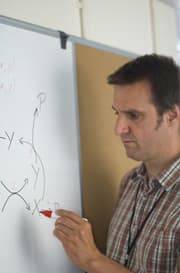Mathematics points to new law in biology
20th May 2011
A paper by a theoretical biologist at the Institute of Food Research has become the most viewed of all time on the journal Biomed Central Systems Biology.
Dr Thomas Wilhelm described the necessary conditions for a fundamental phenomenon in nature, called bistability, that underlies cell division and cell differentiation. Understanding bistability is also important for synthetic biology because bistable switches are a significant biological building block. The findings may even help explain the origins of life.
“Bistability is important for cell growth and renewal and these findings finally answer a fundamental question about the phenomenon,” said Dr Wilhelm from the BBSRC-funded IFR.
There are two basic types of dynamic behaviour in nature, oscillations and bistability. Bistability allows a system to have two different steady states. The system can easily and suddenly switch to the other state. This is important because all cellular decisions have to be unequivocal. For example, apoptois or cell differentiation has to occur fully – it should not stop half way through.
Dr Wilhem has tracked down the smallest chemical systems that show this decisiveness. Based on his discovery, he identified all necessary conditions for bistability. These conditions establish a new mathematical principle that also points to how bistability works in nature.
“A most important property of living systems, like being decisive, might be thought to require a tremendous complexity of components in even the smallest life forms,” said Professor Westerhoff, director of the Manchester centre for integrative systems biology, commenting on the significance of Dr Wilhelm’s findings.
“It turns out this property requires only three, provided that the system fulfils just three requirements.”
In his highly viewed paper, Dr Wilhelm confirmed the need for two conditions for bistability – a positive feedback loop and a mechanism for filtering out small stimuli. He identified a third necessary condition: a mechanism to prevent infinite growth.
“Bistability needs these three conditions. This is a new fundamental law,” said Dr Wilhelm.
“It is indeed strange that nobody has noted this before,” said Professor Westerhoff. “Systems biology can be used to identify unifying principles from within the complexity of life. The paper presents a new law for any dynamic system, including manmade.”
Such a system of chemical reactions is a plausible precursor to life. The origins of life might lie in small self-sustaining systems established by chance and acquiring new reactions to become bigger and more complex. As more compounds and reactions were successfully integrated, a self-sustaining ancient metabolism emerged.
“The system is remarkably robust and provides a more plausible explanation of how life emerged than other previously discussed abrupt phase-transition changes,” said Dr Wilhelm.
Dr Wilhelm is now investigating whether other important transitions such as cancer onset or dendritic cell maturation also involve bistable switches. Resolving these questions would open up new avenues for diagnosis and therapy.
Full reference: The smallest chemical reaction system with bistability
BMC Systems Biology 2009, 3:90
doi:10.1186/1752-0509-3-90
Reference for the method Dr Wilhelm developed for systems analysis: Analysis of structures causing instabilities.
Phys Rev E 2007, 76:011911
doi: 10.1103/PhysRevE.76.011911









